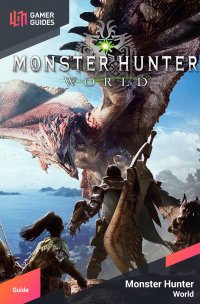Deviljho General Information¶
You can hunt Deviljho if you have the game patched to version 2.00 or greater, after which it’ll appear in 6* and 7* quests, although it can appear during expeditions. The latter is arguably better suited for the purpose, however, as you can check what monsters are in every area. In thise case, if you have every other monster discovered, Deviljho should appear on the monster listing in an area as “???”. However you come across Deviljho, once you’ve spotted it - either by having it invade another quest, or by following its tracks - return to Astera and talk to a Jovial Scholar, who will be marked by a blue exclaimation point.
You will be directed to gather enough Research Points to locate its lair, which you can do by searching enough of its tracks - another task best suited for expeditions. Once you have gained enough Research Points (around enough to hit Research Level one), talk to the Jovial Scholar again to unlock the Special Assignment The Food Chain Dominator. After completing the aforementioned quest, you’ll unlock the optional quest Today’s Special: Hunter Flambé.
| General Information | . |
|---|---|
| Type | Brute Wyvern |
| Quests | The Food Chain Dominator (7*), Today’s Special: Hunter Flambé (7*) |
| Variants | High Rank, Tempered (Threat Level 3) |
Deviljho Strengths and Weaknesses¶
The head and belly of Deviljho will take the most damage from your attacks, both of which are breakable. The tail is also severable.
Deviljho is weak to Thunder and Dragon and not highly resistant to any element, although it is strongest against Ice.
Like the Kulu-Ya-Ku and Tzitzi-Ya-Ku (oddly enough), Deviljho is moderately susceptible to all ailments, so feel free to use whatever ailment you wish.
Deviljho inflicts no ailments, and only infrequently makes use of its Dragon element breath attack. This being the case, you need not concern yourself too much with defensive skills, unless you’re dead-set on trying to negate its roar or the tremor effect its stomp can cause. Boosting offense - and perhaps your health - should be your primary concerns. If you make heavy use of elemental weapons, consider bringing along some Nulberries, in case his breath weapon inflict Dragonblight.
| Elements | . |
|---|---|
| Fire | * * |
| Water | * * |
| Thunder | * * * |
| Ice | * |
| Dragon | * * * |
| Ailments | . |
|---|---|
| Poison | * * |
| Sleep | * * |
| Paralysis | * * |
| Blast | * * |
| Stun | * * |
Deviljho Attacks¶
As you probably saw at the start of the quest The Food Chain Dominator, one of Deviljho’s more spectacular attacks is something of a… collaborative effort, as Deviljho will seize other, smaller monsters in its mouth, and fling them violently about. Not only does this harm its bitten prey, but Deviljho will intentionally use the body of its chew-toy to bludgeon nearby hunters. While you may be able to deter Deviljho from playing with its food with an exceptionally powerful strike or a Flash Pod, but you might as well let the two go at it, stay at a distance, and pick up whatever materials Deviljho shakes loose - it’s not your job to protect the victim monstere, after all.
Most of Deviljho’s offense comes from its maw, which it will use to perform a variety of sweeping attacks, along with the odd lunging bite. Sometimes these bites will rake the ground, spewing up debris, and other times Deviljho will perform combinations of these attacks in sequence, most noteably a three-bite combo which covers a good bit of ground, but a five-bite variant can also be seen from time to time. Simply put, these attacks have a great deal of variety, some have a long attack range, others having a wide attack range. While it might seem like obvious advice to say you should watch out for Deviljho’s maw and try not to tarry in front of it, Deviljho’s relentless aggression and great range make this obvious, practical advice far less effective than it may otherwise seem.
A solution - especially for melee characters - is to try and stay under Deviljho, near its legs. Not only will this allow you to strike its legs (or better yet, its vulnerable belly, if you can manage it), but it’ll provide some safety against its bite attacks. Not that you’re completely safe, however - not only does Deviljho’s constant movement and quick attacks allow it to flush you out (not to mention Monster Hunter World’s constantly sketchy hit detection that seems to allow monsters to hit you with frontal attacks when you’re under or even behind a monster), but it has several attacks that can confounded hunters who mistakenly believe themselves to be positioned safely. The most common of these attacks is a simple, one-legged stomp, which has a thankfully small area-of-effect, but will cause a tremor-effect that’ll stagger nearby hunters.
Other attacks include the common tail sweep (thankfully only one swish with its meaty tail, instead of the standard two sweeps many other monsters performs) and a hip-rush attack that covers a good bit of ground. Another unique attack is its leaping attack (capable of covering a surprisingly distance), which not only may deal damage itself, but if it hits, Deviljho will follow up by biting a stricken hunter, tossing them up in the air, then flinging them aside, dealing even more damage.
As the fight wears on, Deviljho may become enraged, during which time the muscles around its head and neck will become engorged, splitting the skin. The red coloration is unmistakeable. While enraged, Deviljho is even more aggressive, and is capable of making use of a new attack - its breath weapon. Although not devastatingly powerful, it does affect a wide area and utilizes the otherwise rare Dragon element - something you’re more often on the delivery end of. On the plus side, it can be blocked should you come to battle with a shield.
| Carves | Frequency |
|---|---|
| Deviljho Hide | * * * * |
| Deviljho Scale | * * * * |
| Deviljho Talon | * * * |
| Deviljho Tailfang | * * * |
| Deviljho Scalpe | * * |
| Deviljho Gem | * |
| Rewards | Frequency |
|---|---|
| Deviljho Hide | * * * * |
| Deviljho Scale | * * * * |
| Deviljho Talon | * * * |
| Deviljho Tailfang | * * * |
| Deviljho Saliva | * * * |
| Deviljho Tail | * * |
| Monster Hardbone | * * * |
The Deviljho Gem is, as usual, the rare drop for this monster, which is a very rare carve, but you can get another shot at it by breaking the head or chest, or by severing - and carving - the tail. Speaking of which, the Deviljho Tail and Deviljho Scalp are also somewhat rare. The Deviljho Tail can be obtained as a quest reward (two-star rarity), but it’s also a common carve from the severed tail. The Deviljho Scalp can only be obtained as a two-star carve.

 Sign up
Sign up

No Comments